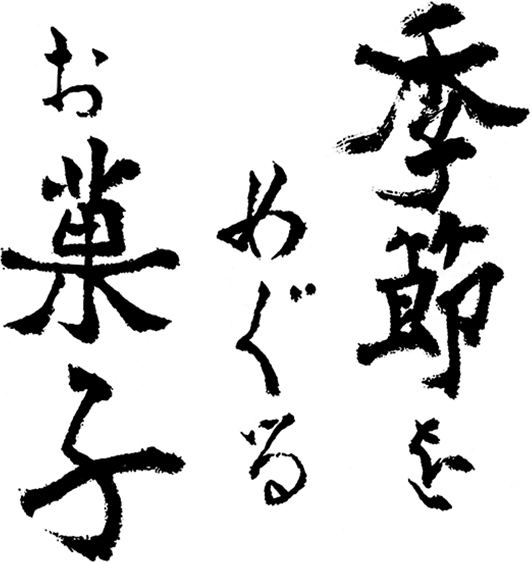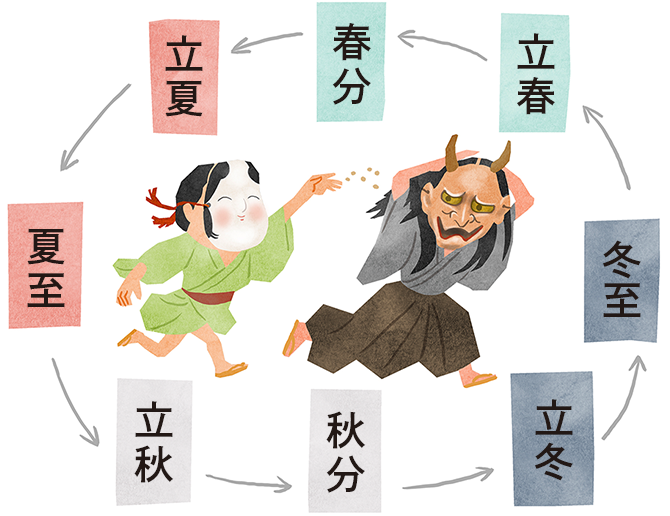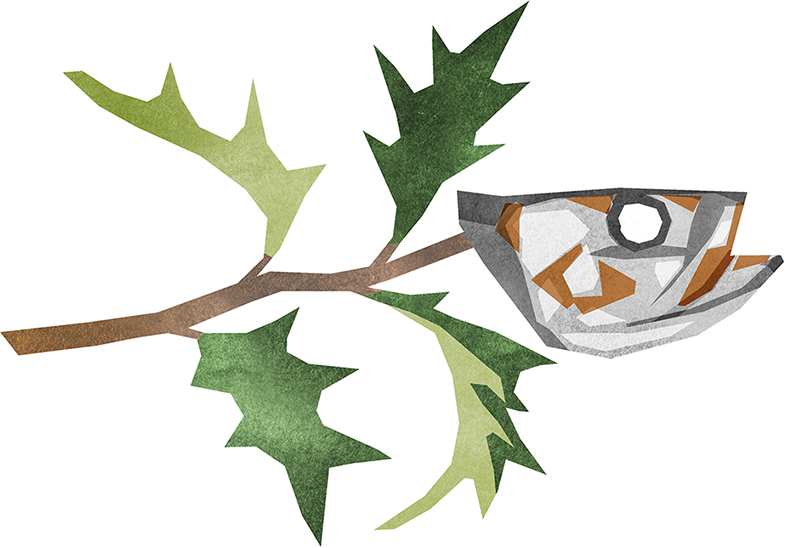 Confectionsfor All Seasons
Confectionsfor All Seasons
Winter / About the confections and their origins
“Oshogatsu and setsubun”

Both in the past and today,
setsubun night has always been highly anticipated
In modern Japan, oshogatsu (New Year’s Day) coincides with January 1st of the Gregorian calendar, but in ancient Japan it coincided with risshun, the first day of spring. In the old calendar based on lunar cycles, the date of January 1st varies from year to year, falling in some cases after mid-February. But the date of risshun was instead established according to the solar cycle, so it falls around February 4th in the new calendar as well.
Setsubun falls on the day before the beginning of spring. Even today, walking outdoors in the cold setsubun night, from wide open windows and doors you can hear voices shouting “Demons out! Fortune inside!”. In supermarkets, sets consisting of oni (demon) masks and beans sell like hotcakes. Family members sometimes challenge each other in paper-stone-scissors to choose who will play the role of the demon.
In the past, on setsubun night people would light their torches, knock on strangers’ doors and loudly chase demons away, spending the night before the New Year in this way. Instead, nowadays demons are cast out by throwing beans at them, and the god of luck is invited to enter people’s houses. Setsubun is very popular among children as they love to throw the beans.

Get rid of the negative influences accumulated during the year by using salted sardines and holly leaves
At the end of the Edo period, salted sardine heads and holly leaves were placed at the entrance to houses to eliminate negative influences. Sardines emit a strong odor when roasted. Regarding the holly, it was thought that the thorns of its leaves could ward off negative influences. This custom is still present today: as setsubun approaches, dried sardines and holly branches are sold as a set.
Speaking of the present, ehomaki is a custom from the hanamachi (districts where geisha live and work) in the Kansai area which has now spread throughout the country. Ehomaki is a large uncut sushi roll, eaten while looking in the lucky direction of the year. Usually, it can also be bought already sliced and eaten without looking in any direction. Perhaps, one of the reasons why this custom immediately found a good response lies in the fact that it allows those who cook not to worry about the family menu for at least one day.
Joy renews as the seasons change
According to the traditional lunisolar calendar, in the past the year was divided into twenty-four periods which coincide with a particular astronomical event or natural phenomenon. The first of these periods is risshun (the first day of spring), the last one is setsubun (the day before the beginning of spring).
Due to the large difference in temperatures, the change of seasons in Japan is always very clear. As a result, agricultural and marine products abound in variety: this is another benefit of enduring cold winters and hot summers.
Let’s pick wakana (young greens) in spring. Let’s go pick bamboo shoots and edible wild plants. Let’s make kusamochi with soft yomogi (Japanese mugwort). Let’s eat bonito in early summer, and somen served cold during the rest of the season. In autumn, let’s enjoy saury, new rice and matsutake mushrooms. In winter, new sake and sake-lees soup. Keeping pace with the seasons, savoring the deliciousness of agricultural and marine products, it is possible to find the joy of living in a country with mountains surrounded by the sea on all sides.
Most of the raw materials for confections are agricultural products. Using the products of a land to create some food that reflects through shape and colors the season in which it is produced is something that we can define as “typically Japanese”. To taste confections is to taste the seasons. We will continue to bring that joy to as many people as possible.